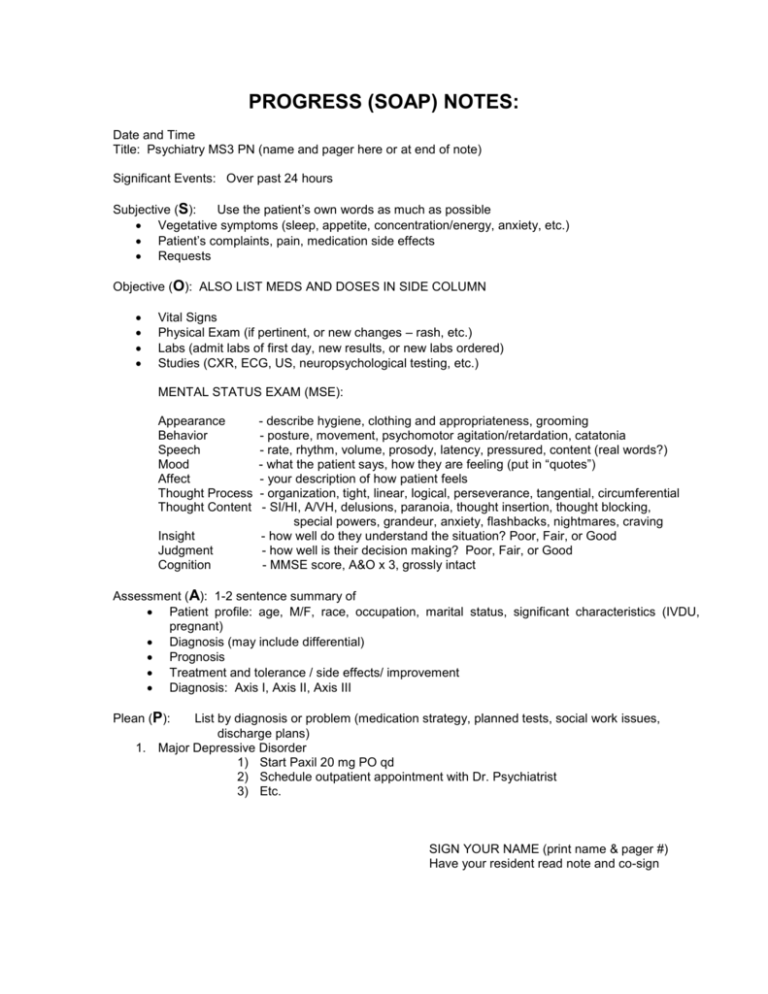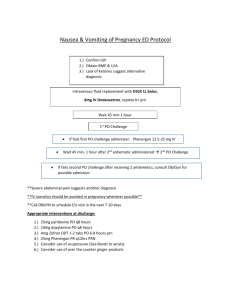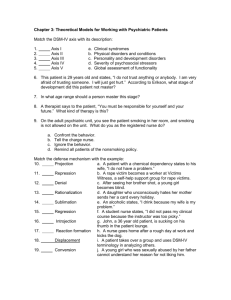PROGRESS (SOAP) NOTES:
advertisement

PROGRESS (SOAP) NOTES: Date and Time Title: Psychiatry MS3 PN (name and pager here or at end of note) Significant Events: Over past 24 hours Subjective (S): Use the patient’s own words as much as possible Vegetative symptoms (sleep, appetite, concentration/energy, anxiety, etc.) Patient’s complaints, pain, medication side effects Requests Objective (O): ALSO LIST MEDS AND DOSES IN SIDE COLUMN Vital Signs Physical Exam (if pertinent, or new changes – rash, etc.) Labs (admit labs of first day, new results, or new labs ordered) Studies (CXR, ECG, US, neuropsychological testing, etc.) MENTAL STATUS EXAM (MSE): Appearance Behavior Speech Mood Affect Thought Process Thought Content Insight Judgment Cognition - describe hygiene, clothing and appropriateness, grooming - posture, movement, psychomotor agitation/retardation, catatonia - rate, rhythm, volume, prosody, latency, pressured, content (real words?) - what the patient says, how they are feeling (put in “quotes”) - your description of how patient feels - organization, tight, linear, logical, perseverance, tangential, circumferential - SI/HI, A/VH, delusions, paranoia, thought insertion, thought blocking, special powers, grandeur, anxiety, flashbacks, nightmares, craving - how well do they understand the situation? Poor, Fair, or Good - how well is their decision making? Poor, Fair, or Good - MMSE score, A&O x 3, grossly intact Assessment (A): 1-2 sentence summary of Patient profile: age, M/F, race, occupation, marital status, significant characteristics (IVDU, pregnant) Diagnosis (may include differential) Prognosis Treatment and tolerance / side effects/ improvement Diagnosis: Axis I, Axis II, Axis III Plean (P): List by diagnosis or problem (medication strategy, planned tests, social work issues, discharge plans) 1. Major Depressive Disorder 1) Start Paxil 20 mg PO qd 2) Schedule outpatient appointment with Dr. Psychiatrist 3) Etc. SIGN YOUR NAME (print name & pager #) Have your resident read note and co-sign Name: MR # Room: Date: ID: CC: HPI: onset duration/course degree of impairment psychological sxs: psychosis: AH/VH cognitive problems: memory mood ∆s: irrit., depr., elation causes what makes it better anyone else w/problem how coping how fix it goals SI/SA/HI somatic sxs: vegetative state weight loss insomnia energy loss anhedonia pain, h/a seizures, head trauma PΨH: HABITS: Tobacco: Rec.drugs/IVDA: ETOH: date started, amt.: SHX: Occupation: Living Conditions: Marital: Military: Education: FHX: Father: Mother: Brother: Sister: Allergies: MSE: General Appearance/Hygiene: Phy/Mental Age: Attitude toward examiner: Cooperative, irritated, seductive, guarded, defensive, indifference, apathetic, sarcastic Behavior: Ψmotor: EC: Tics: Activity: agitation, retardation, fighting Speech: Tone: pressured, resists interruption, expressive, slurred) Rate: (rapid, low) Volume: (loud, soft, hoarse) Affect: Subjective (euthymic, happy, sad, euphoric, SI, HI, guilty, bored, anxious, irritable, agitated, panicky, terrified, angry, enraged, sensual, flat, blunted/restricted, labile, full) Range: (broad, limited) Congruence: (appropriate, labile, superficial) Mood: PMH: 1. 2. 3. 4. 5. 6. 7. 8. 9. 10. MEDS: Thought Process: Logical, goal-oriented:train of thought cam be easily followed Poverty of thought/speech: ↓ability/interest in interacting with environment or answering questions Flight of ideas: thoughts race ahead of ability to communicate them Thought blocking: abrupt cessation of communication Loosening of Associationsns:illogical shifting between unrelated topics Tangential: Thought which wanders from original point Circumstantial: Unnecessary digression which eventually reaches patient Echolalia: Echoing of words and phrases Neologisms: New words invented by patient Clanging: Speech based on sound such as rhyming and punning rather than logical connections Perservation: Repetition of phrases/words in the flow of speech Ideas of Reference: Interpreting unrelated event as having direct reference to patient such as TV talking to them Rambling Thought Content: Preoccupations: phobias, paranoia, obsessions, Compulsions Delusions: nihilism, poverty, somatic distress, sin, grandeur, reference (events apply to self), control (force actions), persecution, erotomania SI/SA, HI, thought/acts of violence Impresssion: Perception Disorders: DSM-IV: Hallucinations: False sensory perceptions: Auditory, Visusal (delirium), Tactile, Gustatory, Olfactory (seizure) Illusions (misinterpretation of stimuli) Depersonalization (fragmentation of self) Derealization (world is not real, things alien and strange) Broadcasting, thought insertion Axis I: Axis II: Cognitive Function: LOC: (hyperalert, alert, lethargic, stupor, coma) Orientation: (person, place, time, situation) Concentration: (sustained attention via serial 7’s/ months backward, requires repetition and redirection, distracted ST Memory: (remember “green, 13, Phil,” at time 0 & 5 minutes Fund of Knowledge: Name past 5 presidents (Clinton, Bush, Reagan, Carter, Ford) Intelligence: (requires formal psychological testing) Abstraction to test TP: (stitch in time saves 9; even monkeys fall out of trees; the tongue is the enemy of the neck; grass is always greener on the other side of fence; don’t count your chickens until they hatch; a golden hammer will knock down iron door) Similarities: how is a tree and a fly alike? Comprehension: story of man with golden brick, Buried. Dug it out to look at it; it was stolen. Why Not paint brick with gold paint? Insight: (awareness of illness, impact of illness on life, expectations from hospitalization, goals) Judgment: (Manage finances, ADLs / IADLs, avoid danger, “found a sealed, addressed, stamped envelope,” “Kitchen is flooded and water running over the sink”) PE: Gen: VS: HEENT: Head: Eyes: Ears: Nose: Oral: Neck: CV: LUNGS: ABD.: SKIN: EXT: NEURO: CN II-XIL, 2/4 DTRs, Cerebellar, Gait MS: ROM, 5/5 Strength Axis III: Axis IV: Homelessness, poor social support, unemployed, chronic mental illness Axis V: GAF Plan: 1. 2. 3. 4. 5. 6. Admit to 1 NW, Green Team Diagnosis Status: voluntary or involuntary (hospital hold) Condition: (good, stable, fair, guarded, critical) Vitals: q shift, routine, q 15” Diet: regular, ADA (diabetic), low sodium, clear liquid, NPO 7. Activity: ad lib., strict bed rest, titrate to milieu per NCP 8. Allergies 9. Routine labs: Complete Metabolic Set: CBC,Chem 7 (CME vs BMS), TSH, Free T4, Y/A, UDS (3-cocaine, MJ, Br, 4-&EtOH; 5-Barb), +/- VDRL/HIV 10. Medications MVI 1po qd MOM 30 cc po q6h prn constipation Mylanta 30 cc po q6h prn dyspepsia Tylenol 650 mg po q6h prn pain Ativan (lorazepam) 1 mg po X1 dose now, then 1-2 mg po/IM q6hours prn agitation. NTE 6 mg/24 hours Inapsine 0.5 cc IM q 6 hours prn severe agitation. NTE 6 mg / 24 hours (or Haldol 1-5 mg) Trazadone 50-60 mg po qhs pm insomnia X one dose for further insomnia (Zolpidern not on formulary) 11. Call HO SPG>175, DBP>95<55, HR>100<55, R>24<&, T>38.3









